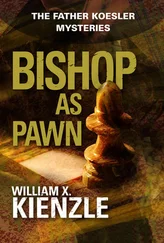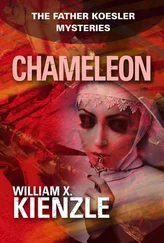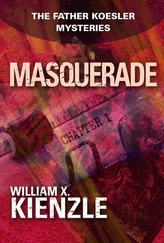Long, long ago, in his early days in Detroit, Toussaint had correctly appraised Koznicki as one of the most astute and effective detectives Toussaint had ever known.
“Since I am familiar with Gallucci’s,” said Koznicki, “perhaps you will permit me to make a few suggestions?”
“Of course. Take over,” Koesler said.
Toussaint merely smiled and nodded.
Koznicki summoned the waiter. “I think a nice Chianti to begin,” he turned to his guests, “and for the antipasto, I would suggest the caponata for both of you.” He looked at the waiter, who nodded. “It is a cold salad of eggplant, celery, capers, tomatoes, olives, vinegar, and sugar,” he explained to his friends. “For a first time at Gallucci’s, it is a good, innocent way to begin. And,” he turned again to the waiter, who realized he was dealing with one who was on easy terms with the menu, “I will have the carpaccio. ”
“Well, where to begin?” said Koesler, as the waiter went about bringing breadsticks and butter, followed by the requested Chianti for the Inspector’s approval. “I guess since much of this is my idea, I’d better bring you up to date, Ramon, on what we suspect is going on.”
Koesler, halting only to permit the waiter to serve the salad, then reviewed with Toussaint what was mostly his hypothesis on the possible connection between the murders of Cardinals Claret and Gattari. The fact that both killings seemed entirely unmotivated and unusual. Both murders were perpetrated by black men in dreadlocks. Both victims were prime candidates for the Papacy. And, finally, the strange appearance of a symbol of black power in the form of a black fist.
“And you are right, Bob, in connecting them, I believe,” said Toussaint, as he set down his wine glass. “I heard some talk on the part of a small segment of the black community in San Francisco after the murder of Cardinal Claret. So I went to Toronto to see for myself. My contacts there corroborated the fact that there is a conspiracy of sorts, but they were not certain where it would lead. Then, at a meeting in San Francisco, my Haitian friends told me they had learned that this conspiracy would spread to Rome. And so it has.”
“But do you know who is responsible? And why?” The questions were Koznicki’s. Before Toussaint could reply, the waiter arrived to clear away the salad dishes.
Koznicki again consulted the menu. “I would recommend, again for a first visit, the Stracciatella. It is eggs, cheese, and nutmeg blended, then poured into boiling chicken broth.”
The waiter’s eyes sparkled in the presence of a bongustaio.
“Fine,” said Koesler.
“I believe I will skip the soup course, Inspector,” said Toussaint.
“As you wish,” said Koznicki. “For myself, I will have the pasta e fagioli. ”
The waiter refilled their glasses with Chianti and departed.
Koznicki, eager for a reply to his questions, nodded at Toussaint.
“It is a long story that I shall try to make as short as possible without omitting any of the essential details,” said Toussaint.
“Perhaps you are aware,” he began, “of the dissatisfaction of many of the home-counties English with the people of many colors who now live in London and its environs—Indians, Africans, Pakistanis, Jamaicans, and so forth. These so-called native peoples have a difficult time making a living and conforming to English mores, particularly in so urban a setting. When the English become unnerved, the classic response from the erstwhile colonials, is ‘We are here because you were there!’ Which means, of course, that the problem is due solely to the fact that Great Britain’s empire once included all its colonies. In making India a British colony, it made the Indians British subjects. If Britain had stayed at home, as it were, so would the Indians have remained in India.
“This concept is even more relevant when one considers Africa,” Toussaint continued as Koznicki and Koesler began their soup. “Black Africans were taken prisoner and removed from their homeland and delivered to the West. To America, where, in the South, they were made slaves to King Cotton. And to island countries, like Haiti and Jamaica. But in those two countries, the Africans experienced vastly different treatment.
“In Haiti, their masters,” Toussaint winced at the word, “were the French. The French considered their slaves to be human, if inferior. Ergo, they were souls to be saved. The slaves were required to be baptized and thus become Catholic. In a sense, I owe my Catholic heritage to Haiti’s French slaveowners. Knowing what I do now, I would choose to be Catholic. But that does not blunt the fact that Catholicism was forced upon the slaves of Haiti.
“The slaves, of course, had little to say about this enforced religion. They simply mixed their new, alien religion with their own religious practice which Westerners know as ‘voodoo.’
“In time, many of the slaves of Haiti either won their freedom or escaped and emigrated to many large cities in many countries. That is why you will find the descendants of former Haitian slaves in virtually all Western urban centers. And with them you will find this amalgam of Roman Catholicism and voodoo.
“The experience of the African slaves of Jamaica was quite different simply because they belonged to the English. And the English considered their slaves not as humans but as property. There were no forced conversions, thus their development was comparatively free from Western influence. But Jamaican slaves suffered one of the highest mortality rates of any of the islands. So the black population growth derived almost entirely from repeated importation of more blacks from many parts of Africa. The form of voodoo that developed in Jamaica was called ‘pocomania,’ or ‘the little madness’ or ‘possession.’ It evolved from a mixture of differing forms of voodoo brought from different parts of Africa.
“But because of the forced mixing of these differing African cultures, there were few shared traditions or experiences. So that different beliefs and different practices evolved in a variety of different groups.”
Just then, their waiter returned, removed the empty dishes and waited with polite curiosity for Koznicki’s order for the next course.
Toussaint consulted his watch. It was growing late and he had much to do before this day was finished. He would have to hurry through this explication. But it was important—very important—that these two should understand.
“Inspector,” said Toussaint, “I will eat no more. I hope you will make allowances. There is much I have yet to do. But please; order for yourself and Bob. I will talk. You will enjoy your meal. We never know how many more meals we have to enjoy before we will eat no more.”
A strange statement, thought Koznicki.
“I will now order the pasta and the entree for the Father and myself. Our friend will have no more,” Koznicki said.
An expression of sadness passed over the waiter’s features. He could not bear to think of anyone’s being only a spectator at a Gallucci meal.
“Father will have the fettuccine .” He turned to Koesler. “It will remind you of egg noodles, Father, only so much better.” He turned again to the waiter. “And I will have your gnocchi. When we have finished, please serve the entree. Father will have the red mullet—you will like that, Father. It is prepared right at the table. And I will have the polio scarpariello. And bring us a bottle of your Orvieto.” He glanced across at Toussaint. “Are you sure you want nothing more? Something to drink, perhaps?”
“Thank you, no, Inspector.”
“Then please go on.”
“I will not burden you with the history of the slave rebellions of Jamaica, the Maroons, or a long list of freedom fighters. For our purpose, I will merely mention Marcus Garvey and his prophecy to the slaves of Jamaica—the slaves who wanted nothing more than to escape what they saw as a massive conspiracy of Western civilization to keep them in bondage and away from their homeland—Africa.
Читать дальше












